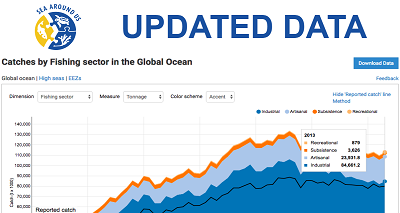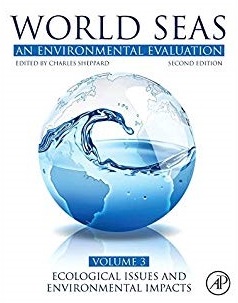The Sea Around Us’ Daniel Pauly and Dirk Zeller have just added a new publication to their long list of items in the literature. In this case, it is a chapter in the recently published book World Seas: An environmental evaluation. Vol. III: Ecological issues and environmental impacts, edited by Charles Sheppard.
In “The making of a global marine fisheries catch database for policy development,” Pauly and Zeller give a detailed account of the process of creating the Sea Around Us’ global catch database that builds on and addresses the deficiencies of the database created and maintained by the Food and Agriculture Organization of the United Nations.
Such deficiencies in the data provided by FAO mirror the omission of discards and fish killed by ghost fishing, and the exclusion of much of the catch of small-scale commercial fisheries, as well as that of subsistence and recreational fisheries in the data countries report to FAO each year, or which FAO estimates in case of non-reporting by countries.
“These deficiencies, with the possible exception of the omission of discards, are not FAO’s fault; rather, they are due to the data its member countries annually supply,” the authors highlight.
But having incomplete information meant that countries did not know how much fish was actually being taken out of their waters either by their own or by foreign vessels, whose fishing efforts have increased over the last 5-6 decades. Thus, in Pauly and Zeller’s view, producing a more complete catch database was an urgent need.
It took a decade
In their account, Pauly and Zeller recall each of the steps needed to create the Sea Around Us database, from the building of a network of almost 400 scientists working across the globe, to the conceptualization of the components each one of them needed to complete in order to reconstruct the catch of the Exclusive Economic Zone(s) they were examining.
The monumental task was full of challenges, but the main one that had to be addressed from the get-go was convincing all the collaborators that, fishing being a social activity that has impacts on other sectors of society, there is no such a thing as “no data.”
“One can use indirect sources, that is, non-fishery sources like household surveys, to help infer the scale of non-reported catches,” the authors explain.
With this mindset, an army of international researchers guided by the Sea Around Us team based at the University of British Columbia worked on reconstructing the catches of 273 EEZs and also created a global “large pelagic” dataset.
A decade later, the job was completed and all the information and data was gathered on the Sea Around Us website and made freely available so that researchers, policymakers and the public can have unrestricted access. At the same time, the trends revealed by the compiled data started to be analyzed.
One of the major findings was that the world’s marine catch over the past 60+ years was about 50 per cent higher than officially reported. “We also demonstrated that this catch has been declining since 1996 –which is also the time when FAO’s reported marine landings begin to decline, although at a lower rate than reconstructed catches,” Pauly and Zeller write in their account.
Global results were published in the much-cited article “Catch reconstructions reveal that global marine fisheries catches are higher than reported and declining,” which appeared in Nature Communications in 2016, as well as in the Global Atlas of Marine Fisheries published that same year. Meanwhile, more than half of the 200 individual, country-level catch reconstructions have been published in peer-reviewed journals such as PLoS One, ICES Journal of Marine Science, Frontiers in Marine Science, Marine Policy, among others.
Open to adjustments
The methods employed for and the results obtained from the Sea Around Us’ catch reconstructions generated a lot of media buzz, as well as heated debates amongst fisheries scientists.
However, Pauly and Zeller reiterate throughout the chapter in World Seas: An environmental evaluation that there is always room for improvement in the catch reconstructions and the online database that hosts them, and that scientists are welcomed to provide their feedback and to actively engage with the Sea Around Us at the University of British Columbia and the Sea Around Us – Indian Ocean at the University of Western Australia to improve them.
The book World Seas: An environmental evaluation Vol. III is available through Elsevier’s Academic Press.




